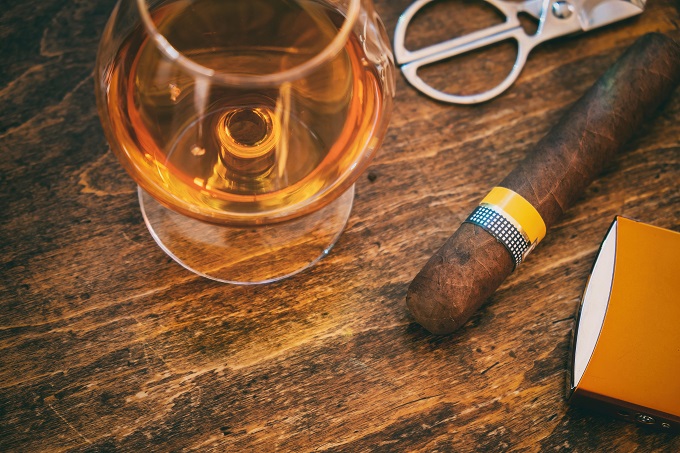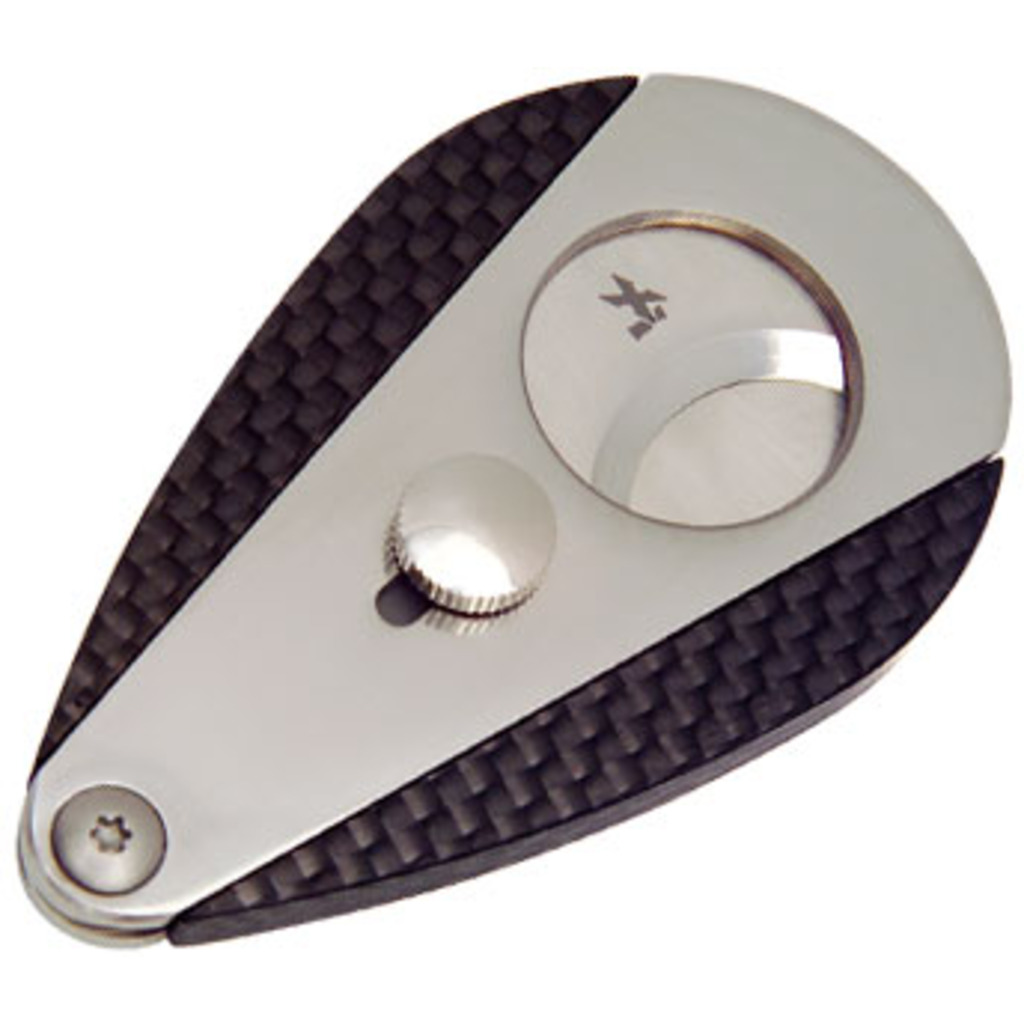Once of life’s simple pleasures is a fine Cuban cigar and a 12 year old single malt whiskey. Having some knowledge about cigars and alcohol, can be impressive.
You know pull out some history about cigars, or the single malt you are drinking, when you are with your mates.
Lets deep dive into cigars and alcohol.
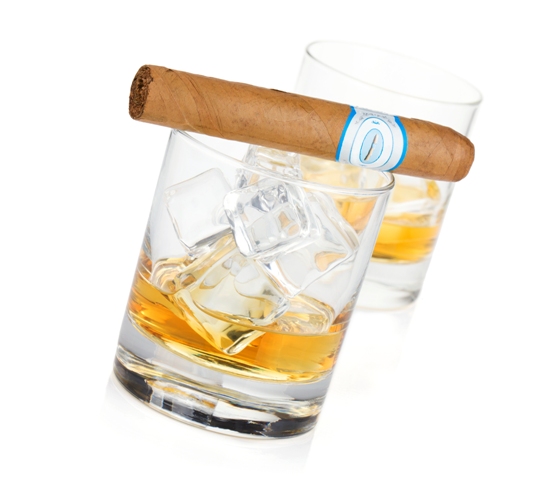
History of Cigars and Tobacco
Have you ever wondered where cigars were first produced? It is widely believed that cigars were first produced in Spain.
But before cigars became all the rage in Europe, tobacco was needed to make them. Tobacco is indigenous to the Americas, where native peoples have produced it for hundreds of years.
It is believed that the Maya of Yucatan peninsula in Mexico and parts of Central America cultivated tobacco, and even smoked it!
Tobacco use gradually spread across various regions, both to the north and south. Historical evidence suggests that its earliest use in what is now the United States likely originated in communities along the Mississippi River.
It wasn’t until Christopher Columbus sailed his famous voyage to the Americas in 1492 that the rest of the world came to know tobacco.
Columbus and cigars
It is said that Columbus was not impressed by tobacco or its use among native peoples, but many sailors grew found of the strange plant.
Soon it quickly caught on in Spain and Portugal. From there, it spread to France, where the French ambassador Jean Nicot lent his name to the scientific name for tobacco (Nicotiana tabacum).
The origins of the word tobacco itself are still suspect, although many believe it is simply a corruption of the word Tobago, which is the name of a Caribbean island.
Still others believe it comes from the word Tabasco, a region (and now state) in Mexico.
The first plantation
The first tobacco plantation in the United States was established in Virginia in 1612. More tobacco plantations followed in Maryland soon after.
Although tobacco became a popular crop, it was only smoked in pipes. The cigar was not introduced to the United States until the late 18th century.
Israel Putnam, an army general who had served in the Revolutionary War, is credited with introducing the cigar to the United States.
He had traveled to Cuba after the Revolutionary War and returned with a box of Cuban cigars.
Their popularity quickly spread, and soon enough cigar factories were established in the area of Harford, Connecticut, where General Putnam resided.
Europe cigar production
In Europe, cigar production and consumption did not achieve widespread popularity until after the Peninsula War in the early 19th century.
British and French veterans returned to their homelands after years of serving in Spain with their tobacco pipes in tow.
Among the rich and fashionable, the favored method of taking tobacco was the cigar. Cigar smoking remains a habit associated with the rich and discriminating of upper society.
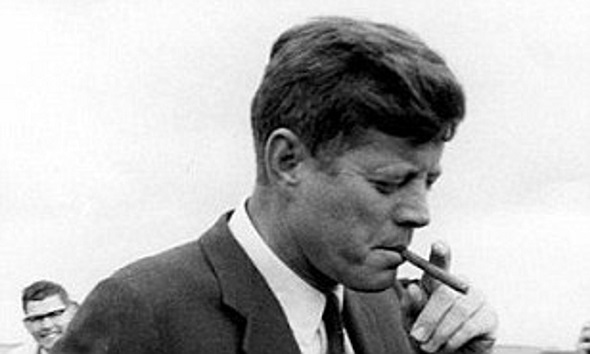
Purchase Cigars from Cuba
Every cigar aficionado knows that the very best cigars come from Cuba. Unfortunately, buying the best can often be a risky proposition.
But many cigar enthusiasts are willing to take the risk to get a taste of the very best. If you’re wondering just how one would get their hands on a box of Cubans, read on.
Because of the relationship between the United States and Cuba, know that there are a lot of people looking to take advantage of cigar aficionados.
Purchasing Cuban cigars should be done with great caution in order to avoid getting duped.
Cuban importing is still illegal in USA
First, know that importing cigars from Cuba is considered illegal. The United States placed economic sanctions on the Cuban government in 1963.
Ever since then, Cuban cigars have become the holy grail of cigar enthusiasts. There is, however, one loophole: visitors to Cuba who return from a sanctioned and licensed visit are allowed to bring back cigars.
However, visitors are not able to bring back more than $100 worth of cigars, and they must be intended for personal use, and not for resale.
Any other ways of obtaining Cuban cigars is considered illegal. It is in fact illegal to buy, sell or trade Cuban cigars in the United States.
Don’t get fined
Fines for illegal trading, buying or selling of Cuban cigars may face up to $55,000 in civil fines. This type of fine, however, is quite rare. The more likely scenario is that you’ll have your cigars confiscated.
When purchasing a box of Cuban cigars, be prepared to fork over quite a bit of your cash. Prices can range from about $150 to $500 or more.
If you’re offered a box below these prices, chances are it may not be the real thing. Most Internet businesses that sell purportedly genuine Cuban cigars tend to be imitations.
Discounted Cuban Cigars
Always avoid shops or retailers that offer “discounted” Cuban cigars.
How to get your hands on the real thing? The easiest way to get a box of authentic Cuban cigars is to head north to Canada.
Buy them in Canada and repackage them so that they are not in their original Cuba packaging. Remove the rings and place the cigars in a different box.
Customs agents tend to not inspect cigars carefully, and it is generally not considered a serious offense to bring Cuban cigars into the United States.
In fact, many clerks at tobacco shops will even offer to repackage Cuban cigars for you.
The other best way is online.
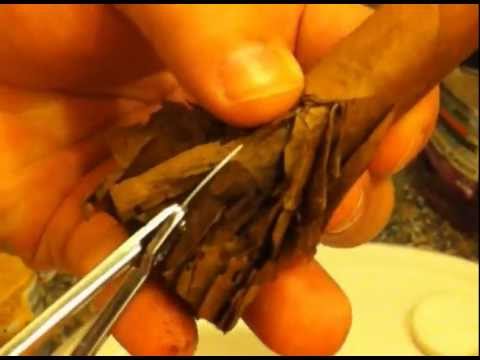
How to Spot Fake Cuban Cigars
Everyone knows that Cuban cigars are the most coveted cigars, renown worldwide for their smoothness and rich flavors.
Indeed, Cuban cigars are so prized that many illegitimate dealers have been known to sell fake Cubans to unsuspecting cigar smokers.
How do you tell if what you have is a fake or the real thing? First, make certain that you purchase your cigars from a legitimate dealer.
Buy from a local
Buying from your local tobacconist or a reputable mail order business can protect you from forking your money over for a box of fake cigars.
If you have an opportunity to purchase a box of purported Cuban cigars, but have your doubts, take the time to examine the box before purchasing it.
Here are a few tips to help you spot the fakes from the real thing.
The most important thing to examine is the box. Authentic Cuban cigars will contain a green and white warranty seal on the left front side of the box.
The seal will contain an insignia that has a picture of a shield and a hat. On the upper right hand corner of the box, you should find a white sticker that is placed diagonally with the word ‘Habanos’ printed on it.
The overall appearance of the box should be neat and clean. If the box appears damaged, smudged, frayed, or marked, avoid it. If the color of the box is dull, don’t buy it.
What is the quality
Even if the cigars are the real things, their quality may have suffered in transport.
If you are in the market for Cohiba, Trinidad, or Q’dorsay brand cigars, know that all authentic Cohiba’s will contain the green and white warranty seal on the right hand side of the box.
On the bottom of the box of cigars, you should find a heat stamp with the words ‘Habanos.’ The heat stamp should be impressed onto the bottom of the box.
Fake Cuban cigar boxes often find other ways to imprint this label, such as using rubber stamps or paper labels.
Does it have a factory code
You should also find a factory code stamp at the bottom that is stamped in green, blue or black ink. This stamp will tell you when and where the cigars were rolled.
If you can open the box, take the time to smell the tobacco. Cuban cigars will have a deep, rich aroma, unmistakable to dedicated cigar aficionados.
If the smell is off, or very weak, chances are you do not have a box of authentic Cuban cigars in your hands. The cigars should be facing the same way, and the top row may appear slightly flattened.
The caps on all the cigars should appear identical, and the foot of each cigar should be cut clean. The bands on all the cigars should also be identical, and should be arranged so that they face the same direction.
If allowed, test the cigars out by pressing down on them. Feel along the entire length of each cigar, checking for soft or hard spots. The cigars should feel firm yet pliable.
Health Risks of Cigar Smoking
We have all heard of the risks associated with smoking cigarettes, but what are the risks of cigar smoking? Are the risks of smoking cigars just as dangerous, or more so?
According to the National Cancer Instituted, regular cigar smoking can result in a major health threat. Scientific research has linked cigar smoking with cancers of the larynx, lungs, esophagus, and oral cavity.
Newer research also indicates that cigar smoking may be strongly linked to the development of cancer in the pancreas.
Doctors also caution that individuals who regularly inhale while enjoying a cigar are also at greater risk of developing lung disease and heart problems.
The health threats of cigar smoking appear to increase dramatically in those individuals who smoke regularly and inhale while smoking.
Some serious risks with this habit
Someone who smokes three to four cigars each day will him or herself at eight times the risk of developing some kind of oral cancer than a nonsmoker.
Unfortunately, we do not yet know the health risks of smoking the occasional cigar. It seems clear however that smoking cigars on a daily basis can pose serious health risks.
Many individuals wonder if cigars are as addictive as cigarettes. Many wonder why, for instance, so many people become addicted to cigarettes, and not cigars?
The truth is that any tobacco product can become addictive because it contains nicotine. Witness the effects of smokeless tobacco products on individuals.
These products, such as chewing tobacco, can become very addictive, simply because they contain tobacco, which in turn contains nicotine.
Many cigar smokers do not inhale deeply, thus causing the nicotine to be inhaled superficially. Cigarette smokers tend to inhale, causing the nicotine to be absorbed faster and more readily by the lungs.
Cigar smoke can hurt
Even though most cigar smokers inhale the nicotine more superficially, it is still possible to become addicted if the user smokes cigars on a regular basis.
If nicotine is so addictive, why don’t more cigar smokers smoke more often? It appears that more people avoid becoming ‘hooked’ on cigars for several reasons.
The most obvious reason is that the nicotine is inhaled much more superficially than in regular cigarette smoking, causing less nicotine to be absorbed by the body.
Also, cigars are not as readily accessible as cigarettes. They are viewed by most as a luxury item, saved for special occasions and used infrequently.
However, when cigars are smoked on a regular basis, they can become addictive. The health risks of any kind of smoking increase dramatically as frequency of use increases.
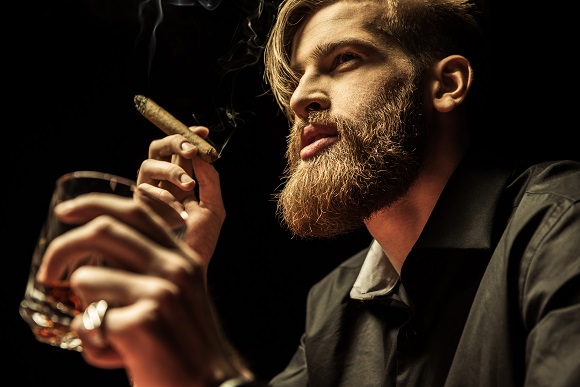
Dangers of Being Exposed to Cigar Smoke
We have all heard about the dangers of inhaling second hand smoke. Many people wonder if the dangers of inhaling cigar smoke are just as dangerous, or more.
Unfortunately, it appears that being exposed to secondhand smoke from a lit cigar can be just as dangerous—or more—than regular cigarette smoke.
All secondhand smoke emitted by tobacco products are classified as environmental tobacco smoke. Environmental tobacco smoke refers to all the secondhand smoke released from tobacco products that are lit, such as cigars or cigarettes.
Research indicates that the smoke from cigars and cigarettes releases many of the same types of irritants. Both cigar and cigarette environmental tobacco smoke contain nicotine, carbon monoxide, hydrogen cyanide, and ammonia.
The environmental tobacco smoke from cigars and cigarettes also releases well-known carcinogens such as vinyl chlorine, benzene, arsenic, hydrocarbons, and nitrosamines.
Does size matter with a cigar
Cigars, because of their size, usually release more environmental tobacco smoke than cigarettes. Being around cigar smoke, then, can pose more of a health threat than inhaling secondhand smoke from a lit cigarette.
Even though both cigars and cigarettes release similarly toxic environmental tobacco smoke, there are some key differences between the two.
These differences are related to the very different ways that cigars and cigarettes are manufactured. The production of cigars consists of a long process of fermentation and aging.
During the production and fermentation process, large amounts of carcinogens are produced. Once a cigar has been fermented and aged, they are wrapped in a nonporous wrapper that keeps the cigar from burning too quickly.
The fermentation process and nonporous wrapper both contribute to the high concentrations of carcinogens in the smoke of al it cigar.
Lighting up a cigar
When a cigar is lit, the carcinogenic compounds produced during the fermentation process are released. The nonporous wrapper also contributes to an unclean burn that is high in carcinogens.
Another reason why cigars produce greater amounts of carcinogens is in their girth and length. Cigars are simply bigger than cigarettes.
Their size allows them to release much more smoke, and in turn, much higher concentrations of toxins and irritants.
Also, cigars are designed to be smoked much more slowly than regular cigarettes, and cigar smokers are encouraged to take their time and enjoy the relaxing experience.
Thinking that cigars and alcohol make a perfect pairing.
This results in longer smoke times, and obviously, the creation of much more smoke. It is advised for all non-smokers to avoid areas where cigars are being smoked.
If you smoke cigars, make sure to do so in a well-ventilated area.
Making the Perfect Cut on Your Cigar
How to clip a cigar properly? Although every cigar aficionado has their own proven method, here are some basic guidelines to get you started.
First, examine the head, or closed end, of the cigar. This is the part of the cigar that will need to be clipped. Determine where the ‘cap’ is.
The cap refers to the part of the cigar where the tobacco leaf was used to close the cigar. Once you’ve found the cap, determine its length.
As a general rule, you should not cut any further than the end of the cap. If you cut further than the cap, there’s a good chance your cigar will unravel!
Use a good quality clipper to cut the head at the cap. You don’t want a cheap cutter that will result in frayed or split cuts.
You can purchase a special cigar cutter at your local tobacco shop that is designed to make clean cuts.
Once you have your cutter, hold your cigar at eye level and make a fast and decisive cut just above the cap. Less is more when cutting—if you find your cut is too superficial, simply cut down a bit more.
How to Pair Cigars and Alcohol
The cigar has long been viewed as a luxury of the rich and powerful. Images of well-to-do men puffing on a stogie and swirling a glass of good brandy have been well documented and memorialized in films and TV. But do they know how to pair cigars and alcohol.
If you are just becoming interested in cigars and would like to relax with a stogie and drink after a long day’s work, here are a few tips to get you started.
Traditionally, the cigar has been paired with a strong drink. Popular spirits include rum, brandy, or whiskey.
Some argue that a good cigar should always be paired with a strong drink that has a hint of sweetness. Indeed, cigar smokers have long enjoyed these popular pairings.
For years, the idea of pairing cigars with beer has gone overlooked. But why overlook good old beer? Recently, the trend has been to pair cigars with various varieties of beer.
It seems that as cigars have entered the mainstream, it has been democratized and popularized. What better way to enjoy a puff of this newly popularized treat than to pair it with beer?
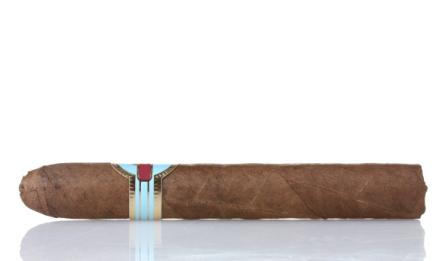
Paring cigars with beer
Pairing a good cigar with a good beer is not an easy feat. If you get it right it is well worth the effort. Much of the pairing has to do with your experience level.
If you are a novice, you will probably need help in pairing your specific cigar with an appropriate beer. If you have a more experienced palate, and you know what you like, you can probably make connections between certain types of cigars and beers.
Because cigars are so strong and flavorful, one of the challenges in pairing is to find a beer that complements the intensity of most cigars. Most cigars will pair nicely with a good barely wine or a single malt scotch.
If your cigar can be described as woody, spicy, with hints of cedar, try pairing it with a barley wine. The fruity hint of barely wine should complement nicely with the spicy flavor of your cigar.
Beer Options for Mild vs Full‑Bodied Cigars
Pairing cigars with beer might not be as traditional as pairing with whiskey or rum, but it’s a growing trend among aficionados.
The right brew can beautifully complement the cigar’s flavor profile—enhancing the tasting experience rather than overpowering it. However, not all cigars (or beers) are created equal, so let’s break it down:
Mild Cigars & Light Beers: A Delicate Match
Mild cigars are typically lighter in body, offering subtle flavors such as cedar, cream, hay, or a slight sweetness. To avoid overwhelming these notes, choose a beer that mirrors this gentleness.
Best Beer Pairings for Mild Cigars:
- Pilsner: Crisp, clean, and lightly bitter—this beer enhances mild cigars like a Macanudo Café or Montecristo White without stealing the show.
- Wheat Beer (Hefeweizen or Witbier): These offer citrusy and spicy notes that blend well with mellow cigars. A Davidoff Signature 2000 pairs beautifully with a cloudy wheat beer.
- Kölsch: Slightly fruity and delicate, it offers enough character to support a mild smoke without overpowering the finish.
Why it works: Light beers allow the subtle creamy or nutty tones of a mild cigar to shine through, creating a smooth and relaxing pairing.
Full‑Bodied Cigars & Bold Beers: Strong Flavors Aligned
Full-bodied cigars are packed with robust flavors—think dark chocolate, black pepper, espresso, or earthy spice. These cigars demand a beer with enough intensity and complexity to match.
Best Beer Pairings for Full-Bodied Cigars:
- Stout or Imperial Stout: Rich and roasted, these beers mirror the earthy depth of cigars like the Padron 1964 Maduro or Oliva Serie V Melanio. Chocolate stouts work exceptionally well.
- Porter: Less intense than a stout, but still full of roasted malt, coffee, and cocoa—great with spicy Nicaraguan cigars.
- Barleywine: A boozy, sweet, and complex beer that pairs well with leathery or peppery cigars. Try it with a Liga Privada No. 9.
- Double IPA (DIPA): If your cigar leans spicy or peppery, a hop-forward IPA offers a strong, bitter contrast that can enhance those bold notes.
Why it works: The bold maltiness and higher ABV of these beers match the cigar’s depth, balancing strength with strength.
Pro Tip: With cigars and alcohol – Match by Flavor, Not Just Strength
Sometimes it’s not about body but flavor harmony:
- A chocolate-forward stout pairs well with a cigar that has cocoa notes.
- A citrusy IPA can cut through an oily Maduro wrapper.
- A spiced ale complements cigars with hints of cinnamon, clove, or nutmeg.
Beer Pairing Summary Table
| Cigar Strength | Flavor Notes | Suggested Beers | Examples |
| Mild | Cream, nuts, cedar | Pilsner, Kölsch, Wheat Beer | Macanudo, Davidoff Signature |
| Medium | Earth, toast, light spice | Amber Ale, Pale Ale, Saison | Romeo y Julieta Reserva |
| Full-Bodied | Pepper, espresso, cocoa | Stout, Porter, Barleywine | Padron 1964, Liga Privada |
Cuban Cigars with Spirits: Pairing Chart & Rationale
Pairing a Cuban cigar with the right spirit is about more than just taste. It’s about elevating your experience. Cuban cigars are world-renowned for their craftsmanship, rich flavor profiles, and smooth complexity.
When matched with a complementary spirit, they can create a truly indulgent ritual of flavor and aroma.
Cuban Cigars & Alcohol Spirit Pairing Chart
| Cuban Cigar | Flavor Profile | Recommended Spirit | Why It Works |
| Cohiba Siglo VI | Creamy, nutty, grassy | Añejo Rum | The rich, sweet rum mirrors the creaminess and balances the spice. |
| Montecristo No. 2 | Medium-full, cocoa, cedar, pepper | Highland Single Malt Scotch | Earthy notes meet smoky malt; smooth finish aligns beautifully. |
| Partagás Serie D No. 4 | Full-bodied, leathery, spicy | Rye Whiskey | Bold rye spice stands up to the cigar’s robust character. |
| Romeo y Julieta Churchill | Medium, floral, slightly sweet | Cognac | Delicate fruit in the cognac enhances the cigar’s floral notes. |
| Bolívar Belicosos Finos | Strong, earthy, peppery | Islay Scotch (Peaty) | Deep peat smoke echoes the earthy cigar flavor, adding depth. |
| Hoyo de Monterrey Epicure No. 2 | Mild-medium, creamy, sweet spice | Bourbon | Bourbon’s vanilla and oak bring out the cigar’s soft sweetness. |
Why These Cigars and Alcohol Pairings Work
Rum & Cohiba
Rum and Cuban cigars share a cultural and climatic origin, making them natural partners. Aged (Añejo) rum has molasses sweetness, mild spice, and oak complexity—perfect for a creamy Cohiba or similarly smooth cigar.
Scotch & Montecristo / Bolívar
Highland single malts, with floral or honeyed notes, complement medium-bodied cigars like the Montecristo No. 2. For more powerful cigars like the Bolívar, an Islay Scotch brings a briny, peaty contrast that matches the bold flavor.
Rye Whiskey & Partagás
Rye whiskey offers spice, bite, and warmth—exactly what you need to match the leathery, spicy body of a Partagás Serie D No. 4. It’s an intense, satisfying combination for seasoned smokers.
Cognac & Romeo y Julieta
Cognac’s fruit-forward and floral qualities mirror the delicate character of a Romeo y Julieta Churchill. This is an elegant pairing perfect for a relaxed evening or celebratory smoke.
Bourbon & Hoyo de Monterrey
Bourbon brings sweetness, vanilla, and oak—all of which highlight the subtle cream and spice in a Hoyo de Monterrey Epicure No. 2. Smooth and approachable, this is an easy favorite.
Cigars and Alcohol Pairing Tips for the Best Experience
- Match intensity: Full-bodied cigars go best with bold spirits; lighter cigars with mellow options.
- Sip slowly: Let the spirit linger on your palate between draws.
- Clean glassware matters: A proper glass enhances aroma—use a Glencairn or snifter if possible.
- Trust your palate: Start with what you enjoy and build from there—don’t be afraid to experiment.
Mastering the Art of Cigars & Alcohol Pairing
When pairing cigars with alcohol—whether it’s beer, whiskey, rum, or cognac—the key is to seek balance and harmony. The right pairing should enhance, not overpower, the experience.
A bold cigar might find unexpected synergy with a fruity beer, while a smooth, creamy cigar can shine alongside a sweet, aged rum. It’s all about letting the flavors complement and elevate each other.
If you’re just starting out, don’t worry about getting it perfect—start with what you enjoy.
Choose a cigar with a flavor profile you appreciate, then explore drinks that either mirror those notes or contrast them in an interesting way.
The most memorable pairings often come from simple curiosity and a willingness to try something new.
Ultimately, pairing cigars and alcohol isn’t about following strict rules—it’s about creating a rich, sensory experience that’s both personal and pleasurable.
Take your time, experiment with confidence, and let your taste guide the journey. The perfect pairing is out there—you just have to light up and sip to find it.

